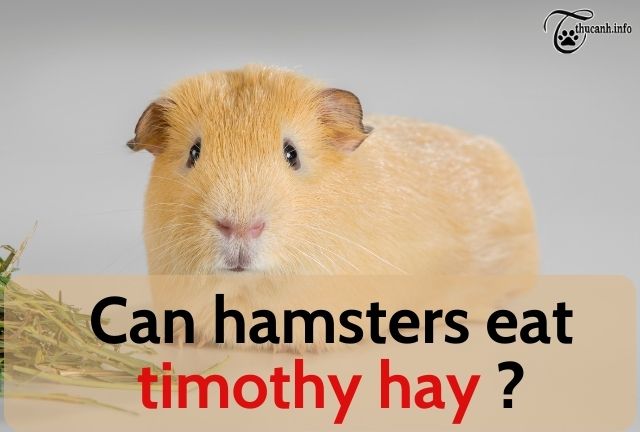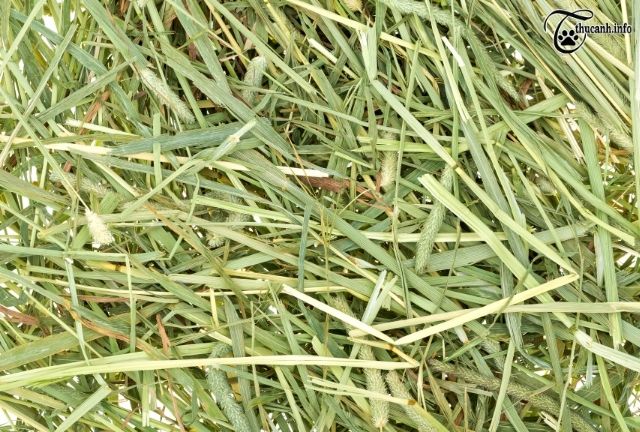Can Hamsters Eat Timothy Hay? If you’re a hamster owner, one of the things that you might be wondering is whether your furry friend can eat timothy hay. After all, this type of hay is often recommended for other small animals like rabbits and guinea pigs.
In this article, we’ll explore the question of whether hamsters can eat timothy hay, as well as the pros and cons of doing so. We’ll also look at some alternatives to timothy hay that you might consider feeding your hamster.

Can hamsters eat timothy hay?
1, Can Hamsters Eat Timothy Hay?
Based on the expertise of scientific experts in the field of pet care and hamster nutrition, the answer to the question “Can hamsters eat timothy hay?” is a resounding yes.
Timothy hay is a crucial component of a hamster’s diet, providing essential fiber that aids in proper digestion and supports dental health. Hamsters are natural foragers, and timothy hay serves as a beneficial and enriching addition to their daily food intake.
The high-fiber content in timothy hay helps regulate a hamster’s digestive system, preventing potential issues such as constipation and gastrointestinal disturbances. Moreover, hamsters enjoy nibbling on the hay, which keeps their teeth in check, preventing overgrowth and dental problems.
As responsible hamster owners, offering a constant supply of fresh timothy hay is highly recommended. It not only promotes a healthy digestive system and dental hygiene but also serves as a form of mental stimulation for these curious and intelligent creatures.
In conclusion, incorporating timothy hay into a hamster’s diet is both scientifically supported and beneficial for their overall well-being. As with any dietary changes or questions, it’s always advisable to consult a veterinarian specializing in small animals to ensure your hamster’s specific nutritional needs are met.
2, Introduction to Timothy Hay and Its Benefits for Hamsters
2.1, What is Timothy Hay?

Can hamsters eat western timothy hay?
Timothy hay is a type of grass hay that is commonly fed to small animals, including hamsters. It is named after Timothy Hanson, an American farmer who promoted its use as a nutritious feed for livestock. Timothy hay is known for its high fiber content, which is essential for a hamster’s digestive health.
It also contains important nutrients like protein, calcium, and phosphorus. Offering timothy hay as part of your hamster’s diet can help support dental health, prevent obesity, and provide them with an engaging activity as they enjoy nibbling on the hay.
2.2, The Importance of Timothy Hay for Hamsters
Here, we will explore the significance of timothy hay in a hamster’s diet. As herbivores, hamsters need a diet rich in fiber to support their digestive health. Timothy hay serves as an excellent source of long-strand fiber that aids in proper digestion and helps prevent digestive issues such as constipation.
3, Who Can Benefit from Feeding Hamsters Timothy Hay?
3.1, Understanding the Potential Benefits for Hamsters
Including a variety of nutritious foods in your hamster’s diet can have several positive effects on their overall health and well-being. Providing fresh fruits and vegetables, along with high-quality hamster pellets and hay, can ensure they receive essential vitamins, minerals, and fiber. Regularly offering treats like fresh fruits, vegetables, and small insects (such as crickets) can also enrich their diet and provide mental stimulation.
However, it’s crucial to offer treats in moderation and choose suitable options that won’t cause any harm. By understanding the potential benefits of a balanced diet, you can help your hamster lead a happy and healthy life.
3.2, Factors to Consider Before Feeding Timothy Hay to Your Hamster
Here, we will address important considerations before incorporating timothy hay into your hamster’s diet. While timothy hay is generally safe for hamsters, individual hamsters may have specific dietary needs or health conditions that require careful attention. Consulting a veterinarian experienced in small animal care can provide valuable guidance.
Overall, the addition of timothy hay to a hamster’s diet offers numerous advantages and aligns with their natural feeding habits. It is essential to provide fresh, clean hay at all times and monitor your hamster’s response to ensure they benefit fully from this nutritious and enriching dietary component.
4, Nutritional Value of Timothy Hay for Hamsters
4.1, Fiber Content and Digestive Health Benefits
In this section, we will explore the nutritional aspects of timothy hay and its positive impact on a hamster’s digestive health. Timothy hay is rich in dietary fiber, which plays a crucial role in maintaining healthy digestion for hamsters. The fibrous nature of timothy hay aids in regulating bowel movements and preventing digestive issues, such as bloating and constipation.
4.2, Dental Health Support from Timothy Hay
Here, we will discuss how timothy hay contributes to the dental health of hamsters. As rodents with continuously growing teeth, hamsters require regular gnawing to keep their teeth at a manageable length. Timothy hay’s tough and fibrous texture promotes natural chewing behavior, helping to wear down their teeth and prevent overgrowth, which can lead to dental problems.
4.3, Encouraging Natural Foraging Behavior
This section will focus on how timothy hay can encourage natural foraging behavior in hamsters. In the wild, hamsters spend a significant portion of their time foraging for food. Providing timothy hay in their habitat mimics this behavior, stimulating mental and physical activity, and promoting a more enriched environment for the hamster.
Timothy hay is a crucial component of a hamster’s diet and should be available to them at all times. Unlike other types of hay, Timothy hay is lower in calcium and protein, making it an ideal choice for hamsters. Its high fiber content aids in digestion and helps maintain healthy dental health by wearing down their constantly growing teeth.
4.4, Incorporating Timothy Hay into Regular Feeding Routine
To incorporate Timothy hay into your hamster’s regular feeding routine, ensure it is accessible in their cage at all times. Use a hay rack or place it directly on the cage floor, providing easy access. Your hamster will naturally forage for the hay, promoting mental stimulation and preventing boredom. Remember to check and refresh the hay regularly to keep it fresh and free of contaminants. By making Timothy hay a constant part of your hamster’s diet, you contribute to their overall well-being and ensure they lead a happy and healthy life.
4.5, Tailoring Timothy Hay Consumption to Individual Hamster’s Preferences
Here, we will discuss how to adjust timothy hay consumption based on your hamster’s preferences and needs. While most hamsters enjoy timothy hay, individual preferences can vary. Observe your hamster’s response to timothy hay and adjust the amount provided accordingly. Additionally, if your hamster has specific health conditions or dietary requirements, consult with a veterinarian to ensure they receive the appropriate amount of hay in their diet.
Overall, incorporating timothy hay into your hamster’s diet provides essential nutritional benefits, supports dental health, and encourages natural behaviors, contributing to their overall well-being and happiness.
5, How to Introduce Timothy Hay into Your Hamster’s Diet

Can hamsters have timothy grass?
5.1, Gradually Introducing Timothy Hay to Your Hamster
When introducing timothy hay to your hamster’s diet, it’s essential to do so gradually. Start by offering a small amount of hay and observe how your hamster responds. Some hamsters may take to it immediately, while others may need some time to get accustomed to the new food.
5.2, Monitoring Your Hamster’s Reaction and Adjusting as Needed
As you introduce timothy hay, closely monitor your hamster’s reaction. Ensure they are eating and showing signs of enjoyment. If your hamster seems disinterested or refuses to eat the hay, try different presentation methods, such as placing it in a hay rack or mixing it with their regular food. If your hamster continues to show reluctance, consult with a veterinarian for guidance.
6, Alternatives to Timothy Hay for a Balanced Hamster Diet
6.1, Exploring Other Nutritious Hay Options
If your hamster does not take to timothy hay, there are other nutritious hay options you can consider. Meadow hay, orchard grass hay, or oat hay are some alternatives that can provide similar nutritional benefits to timothy hay. Offer these options and observe your hamster’s preference.
6.2, Incorporating Fresh Vegetables and Fruits into Your Hamster’s Diet
In addition to hay, fresh vegetables and fruits can be an essential part of your hamster’s diet. Ensure you provide hamster-safe options, such as carrots, cucumber, or apple slices, in moderation. These fresh foods can add variety and additional nutrients to their diet.
Can hamsters eat timothy hay? Acorrding to Thu canh, timothy hay is a valuable addition to your hamster’s diet. It provides essential dietary fiber, supports dental health, and encourages natural foraging behavior. Remember to introduce hay gradually, monitor your hamster’s reaction, and adjust their diet as needed.
If timothy hay is not preferred, explore other hay options and include fresh vegetables and fruits for a balanced and healthy diet. Always prioritize your hamster’s well-being and consult with a veterinarian for personalized dietary recommendations.


